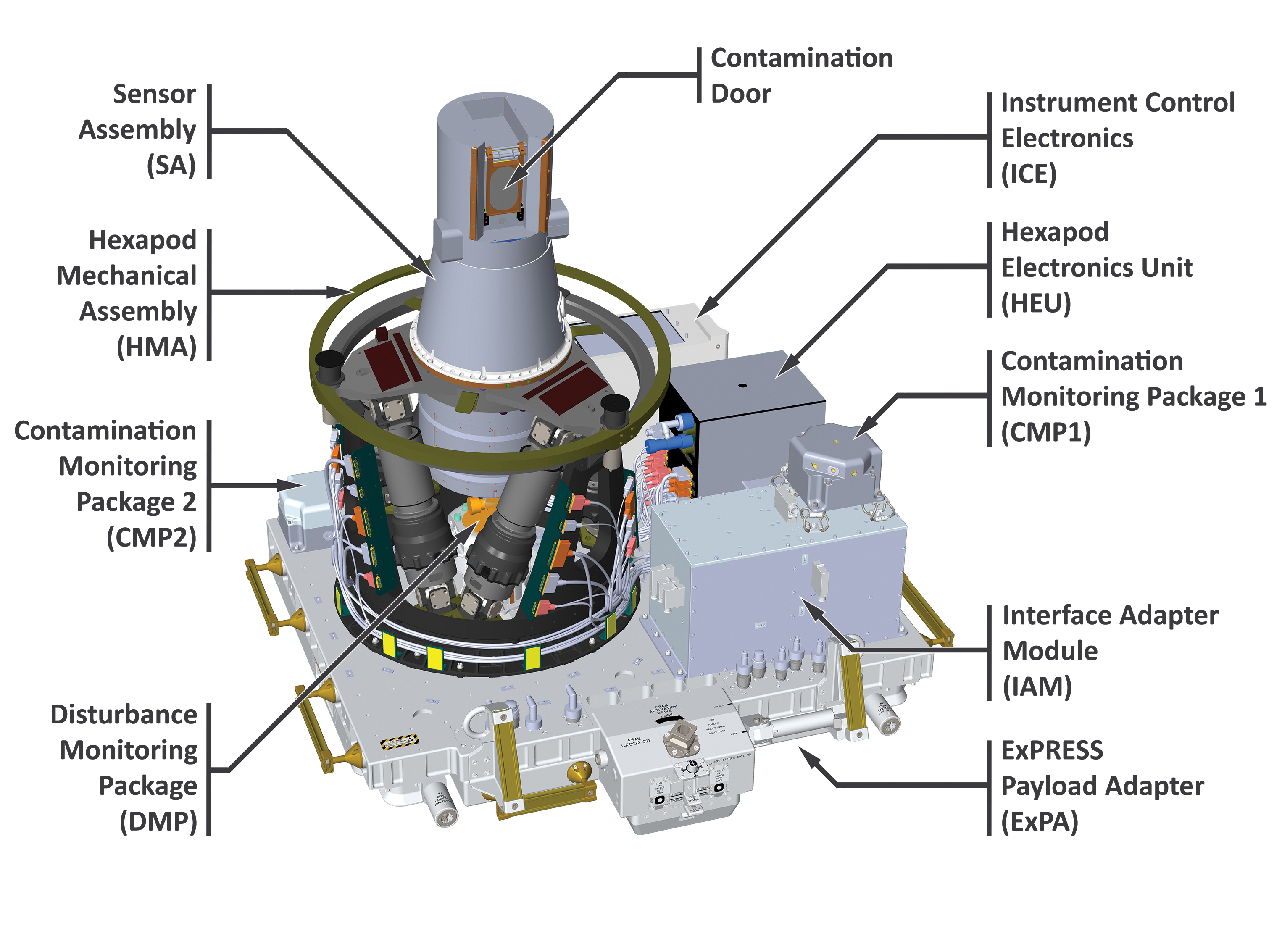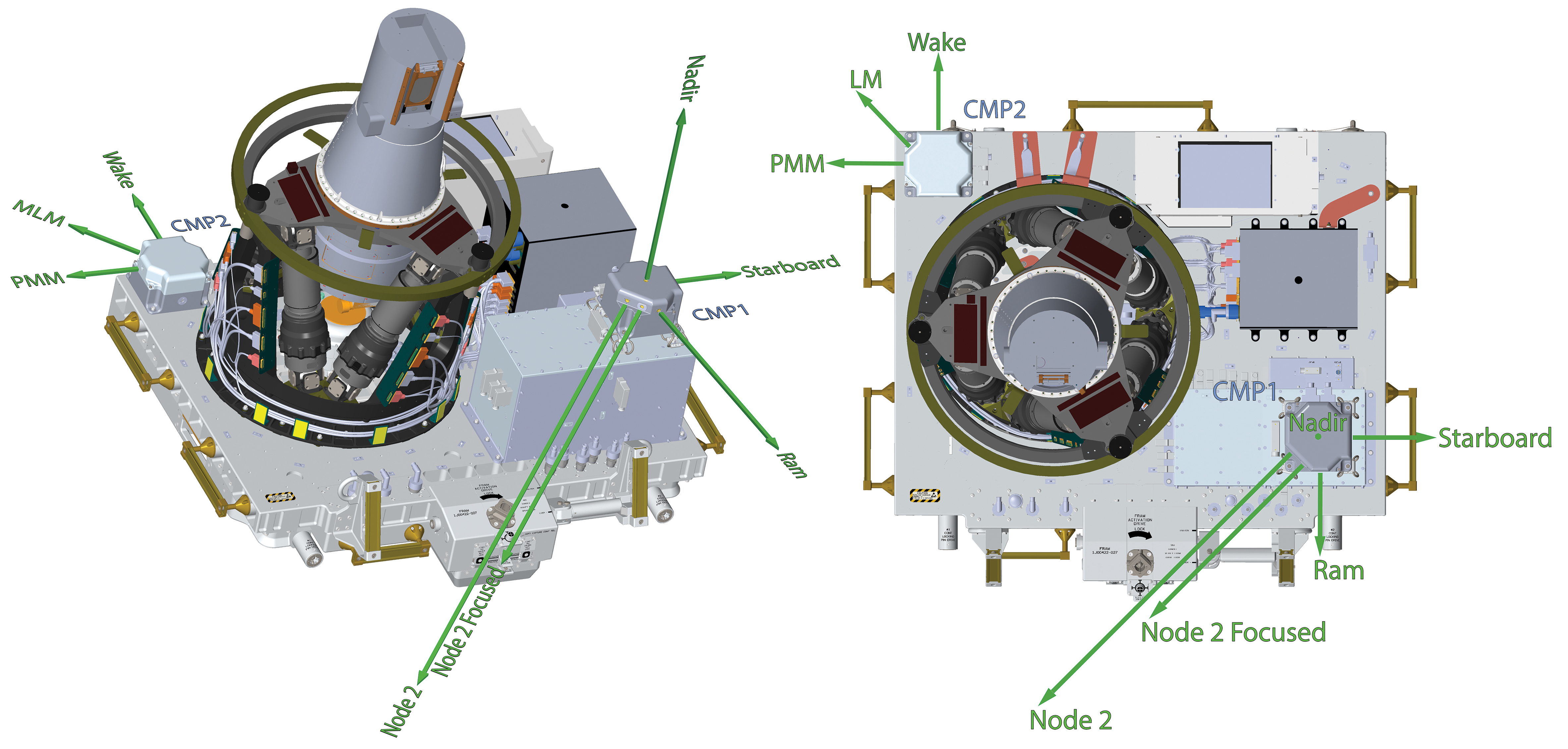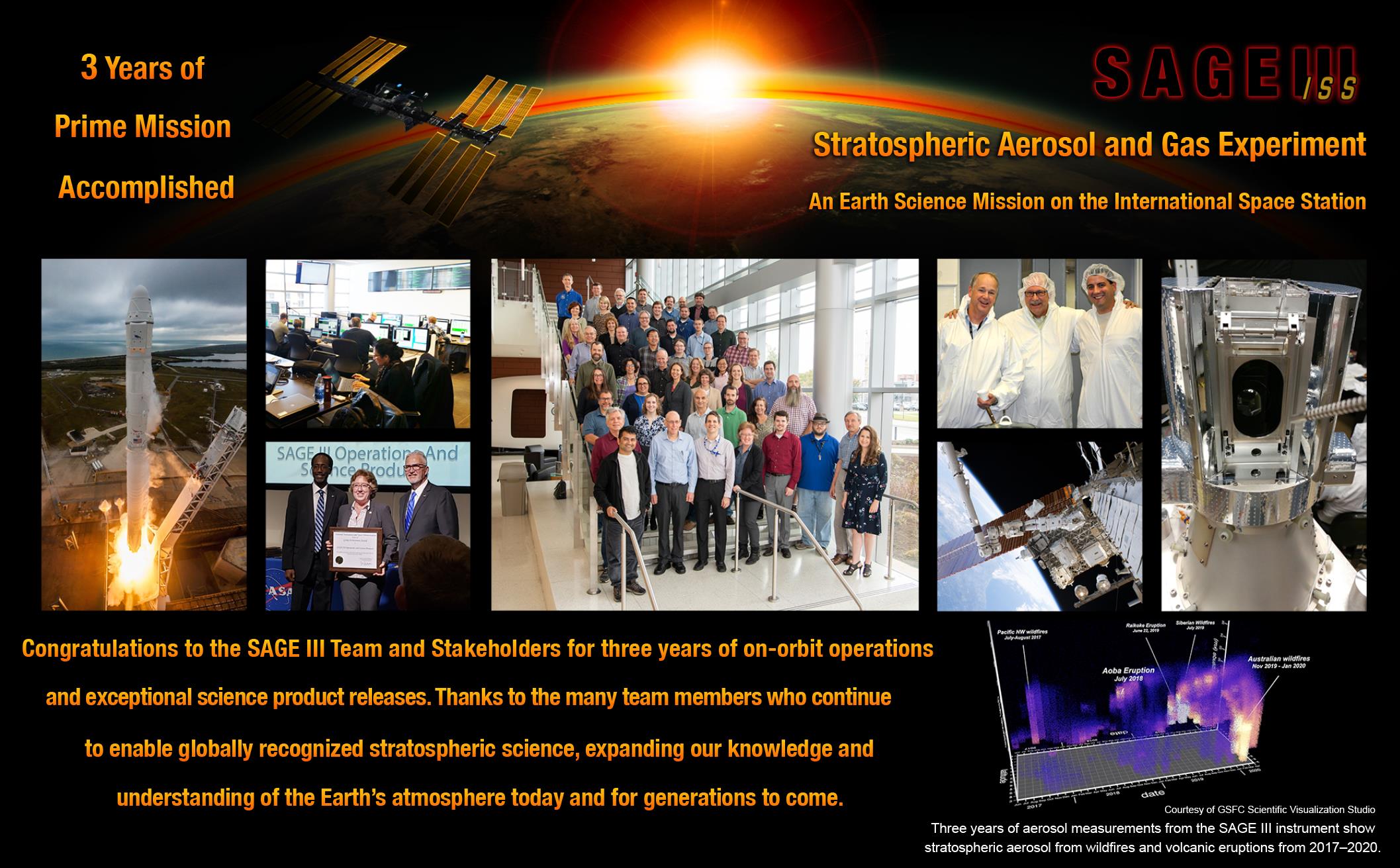Spatial / Temporal Coverage
- Spatial Coverage: 70N to 70S
- Spatial Resolution: .5km vertical
- Temporal Coverage: 03/17/2017 – Present
- Temporal Resolution: 1 file per event
Data Products
- Ozone (solar and lunar)
- Aerosol Extinction Profiles
- Water Vapor
- Nitrogen Dioxide (solar and lunar)
- Nitrogen Trioxide (lunar)
Science Data Processing
The Level 1 and 2 science products are derived from the Level 0 data by algorithms running in the SAGE III/ISS Science Computing Facility (SCF) located at NASA Langley Research Center (LaRC). External ancillary data sources needed to proceed with Level 1 and 2 processing are: observation time/location and pressure/temperature profiles of the neutral atmosphere. GPS time and ISS position/velocity are standard products provided by ISS and are incorporated into the nominal SAGE III/ISS payload data stream. At the advice of the pre-flight ROSES selected Science Utilization Team, the Modern-Era Retrospective analysis for Research and Applications, Version 2 (MERRA-2) is used for temperature/pressure profiles of the neutral atmosphere. This is the same ancillary source used in creating the SAGE II V7 record. MERRA-2 is generally available three weeks after the end of the preceding month. Once the necessary ancillary information is available, processing a month of occultations is complete within a day or so.
The mission team reviews the results to assess the overall quality and remove any obvious failures, which are rare, not flagged by automated checks of data consistency, or stressing cases that are used for product improvement. Cleared data are then posted to the LaRC Distributed Active Archive Center (DAAC) for public distribution. These steps are usually completed within the required 10 days from receipt of the necessary inputs.
The SAGE III/ISS SCF processing system architecture consists of two Linux-based servers that act as a data storage and production pair. The complete system has two of these pairs: one performs the standard processing on a monthly cadence; the other pair is for research/development processing and supplying redundant capabilities during reprocessing campaigns, such as for the initial release of version 5.1 products. There are also three Linux-based development servers that primarily act as development servers, though they also hold a copy of the raw, level 0, and intermediate files, and can act as backup servers for production. These development servers are also used for analysis, testing, and validation of the Level 1 and Level 2 data products. All seven of these servers have been verified to produce identical results between various stages of processing.
The SAGE III/ISS Mission is proud to announce the second official release of SAGE III/ISS products (v5.3) that are suitable for use in both validation and research studies for the data products as described in the Data Product User’s Guide (DPUG). The nominal monthly release of new SAGE III/ISS events will be processed only with the v5.3 algorithm starting with February 2023. Legacy v5.2 products remain publicly available for events from June 2017 through January 2023. This statement applies to SAGE III/ISS v5.3 Solar Level 1B, Solar Level 2, and Lunar Level 2 data products. The SAGE III/ISS Team recommends upgrading to v5.3 from v5.2 because of improvements in the process of quality assurance and a novel correction scheme for mechanical disturbances resulting in reduced product uncertainties.
Vertical profiles of ozone, nitrogen dioxide (NO2), and water vapor (H2O) concentrations, as well as multi-wavelength aerosol extinction coefficient, are included in the solar Level 2 data product files. Three ozone profiles are available in this release of the solar products: an UV based mesospheric product (i.e., “Ozone_Mes” in the product files) and two Chappuis-based products. One Chappuis-based product uses a spectrally-focused fitting retrieval (i.e., “Ozone_MLR”) while the other uses a broad-spectrum retrieval scheme that is similar to that of SAGE II (i.e.,“Ozone_AO3”). Composite ozone and retrieved temperature/pressure products are not included in the v5.3 data set. Vertical profiles of ozone, nitrogen dioxide (NO2), and nitrogen trioxide (NO3) concentrations are included in the lunar Level 2 product files. Chlorine Dioxide (OClO) from lunar occultation is not included in this release. The channel wavelengths used in solar and lunar retrievals are available in the DPUG.
When compared to v5.2, v5.3 improvements resulted in a net gain of 127 solar events through the end of 2022. There was a net loss of 11 lunar events between versions for this period.
SAGE III/ISS Data Products User’s Guide: Version 5.3, February 2023
Stratospheric aerosol plays an important role in chemistry and climate. Space-based observations of their optical properties have been key elements of the study of the effects of major volcanic and extreme fire events. To aid users of SAGE III/ISS Level 2 aerosol data, the mission is releasing a Level 2 aerosol auxiliary product that identifies cloud-free observations using the method of Kovilakam et al. 2023 (https://doi.org/10.5194/amt-16-2709-2023). The algorithm is similar to that developed for the Global Space-based Stratospheric Aerosol Climatology (GloSSAC), in which SAGE III/ISS data plays a crucial role alongside other space-based measurements (asdc.larc.nasa.gov/project/GloSSAC ). The new Level 2 aerosol auxiliary product is released at the same cadence as the L2 solar products. For general ease of use, the results are grouped into monthly netcdf file.
Read more about SAGE III data:
SAGE III/ISS First Atmospheric Data Release
SAGE III/ISS Lunar Data Release
SAGE III/ISS Observes 2017 British Columbia Wildfires
SAGE III Instrument Observes Aerosol Spike from Australian Fires
SAGE III Sees California Wildfire Effects in Stratosphere
Studying Earth’s Stratospheric Water Vapor
Enhanced Stratospheric Aerosols from Fukutoku-Okanoba Eruption
SAGE III Instrument Detects Stratospheric Effects of Indonesian Volcanic Eruption







